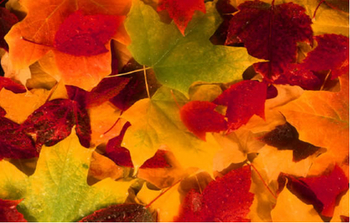
In nature, loud colors aren’t usually an afterthought. Mate with me, says many a strutting bird, vibrant plumage on full display. Don’t eat me, shouts the poisonous plant. Yet, for a long time, no one considered that the most noticeable of color shows—the slow, then sudden, wave of warm shades that sweeps through our forests each year—might have its own hidden meaning.
Trees mark the arrival of autumn not by a sudden chill or crisp breeze, but by the steadily lengthening night. They loose their green as the leaves stop producing chlorophyll, the energy-harnessing chemical they will no longer need during their winter hibernation. The red oaks, yellow poplars, and orange sugar maples that we see emerge so gloriously are the resulting pigment leftovers, now unencumbered by the all-enveloping green.
|
|
It might seem the colors are an accident—that they are in fact beautiful is beside the point, evolutionarily speaking. But there’s more to the story than that. The red pigment, called anthocyanine, turns out to be a little different than the orange and yellow hues, which are always present in the leaf but only masked by the chlorophyll. In the early fall, trees specifically manufacture the red, just at the time when they should be more concerned with other matters. How many other organisms, after all, become more beautiful just before they die?
Scientists for a long time have debated why anthocyanins exist. Some cite the benefits this chemical confers on the plant as reason for this burst of red. The chemical is a powerful antioxidant that also helps the leaves along in their last gasps for energy. More recently, though, another theory has emerged—that, maybe, the red is communicating a message to another species (hint, it’s not us).
It's aphids. The vibrant firey shade is quite distasteful to them, to the extent that it actually repels the bugs, which like to dine on the tree's sap. No one knows how their visual systems actually perceive the red, but that’s another story. In the leaf’s struggle to hang on just one more day, we are concerned only that the aphid has left. A study published last month was the one to report these results, which help shore up this aphid hypothesis. In the study, aphids, though supposedly red-green colorblind, were most attracted to yellow leaves, then to green, and lastly to the red. By this way of thinking, red may be an expensive blush concealing the yellow pigment that lurks underneath.
And on that note, enjoy the approaching fall foliage! Today is the first day of my favorite season, as the Google homepage faithfully reminded me this morning.

